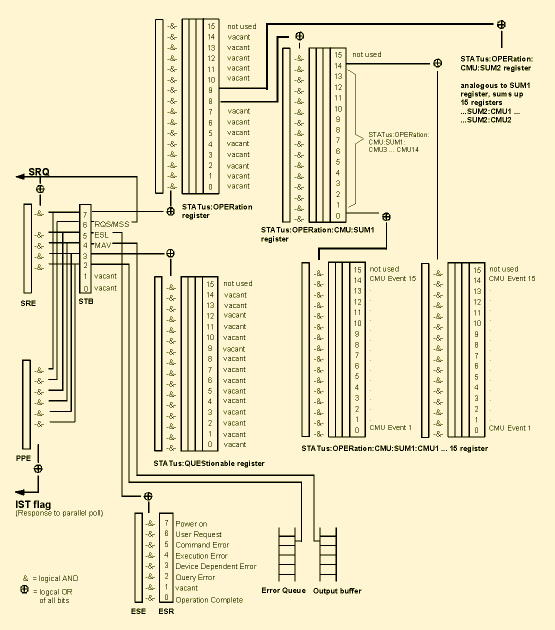


The figure below shows the status registers used in the CMU. The STATus:QUEStionable register is not used. In addition to the standard STATus:OPERation register, the CMU offers 30 independent STATus:OPERation:CMU:SUM1|2:CMU<nr> sub-registers (<nr>=1 ... 15).
| Cascading registers | The hierarchical structure of the STATus:OPERation register
was designed with the aim of reporting and specifying the events generated
during different measurements independently. Each sub-register receives
entries from a particular combination of a function group and signalling
mode (e.g. RF Non Signalling, GSM900-MS Signalling etc.). The function
groups and modes are identified by means of their secondary address, an
integer number between 0 and 29. Secondary address 0 is reserved for the
CMU base system. The remaining secondary addresses can be arbitrarily
assigned or queried via the SYSTem:REMote:ADDRess:SECondary
command (see Introduction
- Commands). The assignment between sub-registers and secondary addresses
is as follows: |
| Sub-register | Secondary Address | Sub-register | Secondary Address | |
| STAT:OPER:CMU:SUM1:CMU1 | 0 (reserved for CMU base system) |
STAT:OPER:CMU:SUM2:CMU1 | 15 | |
| ... | ... | ... | ... | |
| STAT:OPER:CMU:SUM1:CMU15 | 14 | STAT:OPER:CMU:SUM2:CMU15 | 29 |
| Contents of the sub-registers | The higher-level STATus:OPERation registers summarize the
sub-registers as shown in the figure below. E.g., if the corresponding
ENABle bit is set, any EVENt reported in one of the STATus:OPERation:CMU:SUM1|2:CMU<nr>
sub-registers sets the sum bit of the STATus:OPERation:CMU:SUM1|2 register
to 1.
This means that the STATus:OPERation register indicates whether any event occurred, the lower-level STATus:OPERation:CMU:SUM1|2 registers indicate the function group and signalling mode in which the event occurred, the lowest-level STATus:OPERation:CMU:SUM1|2 registers indicate the nature of the individual events. The meaning of the bits in function group RF Non Signalling is given below (see section STATus:OPERation Register). For other function groups refer to the relevant manuals. |
| Accessing the sub-registers |
Every single status register can be configured and queried individually by means of the commands of the STATus:OPERation subsystem (see Introduction - Commands). |
